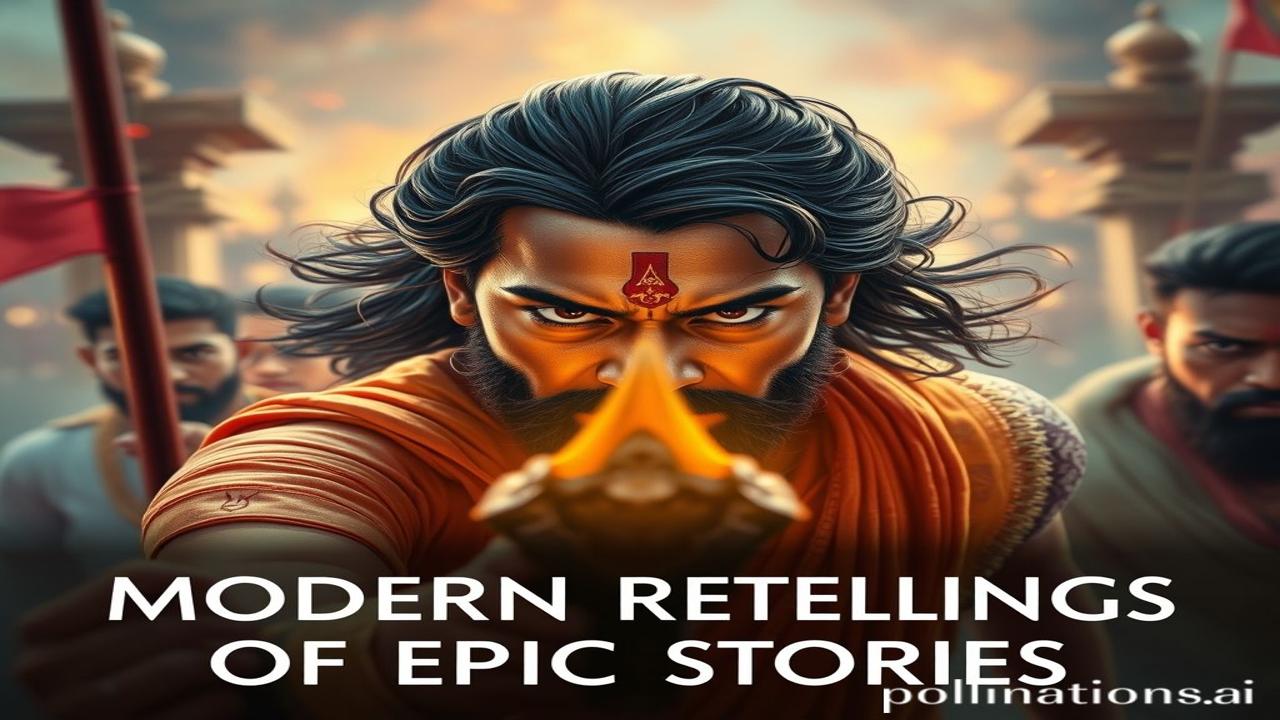Waqt Ki Dhool Mein: Modern Retellings of Epic Stories – Ek Safar!
Kabhi socha hai, woh purani kahaniyan, jo humne apni nanimaa se suni thi, aaj bhi humare aas paas hain? Waqt ki dhool mein chhupi, lekin dil mein zinda. Ramayan, Mahabharat, aur unke jaise aneko epic stories… Kya hota agar yeh sab aaj ke zamane mein phir se batai jaati? Kya unka asli essence wahi rehta, ya badal jaata? Let’s find out!
इतिहासिक पृष्ठभूमि / Historical & Cultural Context: Ek Nazar
What are epic stories, yaar? Basically, yeh woh badi-badi, often-heroic narratives hain, jo kisi culture ke liye bahut important hoti hain. In mein values hote hain, lessons hote hain, aur history ke echoes bhi. India mein, we’re talking about the Ramayana (written by Valmiki around 400 BCE), the Mahabharata (compiled over centuries, starting around 400 BCE), and even older tales like the Puranas.
These stories aren’t just entertainment; they’re dharohar (heritage). They teach us about dharma (duty), karma (action and consequence), and moksha (liberation). They shape our understanding of right and wrong, good and evil. And guess what? These stories are still being retold today, in movies, books, plays, and even video games! The challenge is, can we capture the atma (soul) of the original while making it relevant for a modern audience?
ज़मीनी सच – लोग और जीवन / Deep Dive with Human Element: Phir Se Jeevit!
Imagine the Ramayana, but Ram is a CEO struggling with ethical dilemmas in a corporate world. Sita is a journalist fighting for truth against powerful forces. Ravan is a charismatic but ruthless businessman. Humare zamane ke heroes aur villains, problems wahi, but context alag.
Or take the Mahabharata. Arjun is a soldier battling PTSD after a modern war. Draupadi is a woman fighting for equality and agency in a patriarchal society. Krishna is a wise advisor helping Arjun navigate the moral complexities of the world.
“Ma Rukmini ne aaj naye kapde pehne, kyunki mandir mein utsav tha…” – The same excitement, the same devotion, could be shown in a modern setting too. Maybe Rukmini is now a social media influencer, sharing her spiritual journey with millions. The external form changes, but the bhakti (devotion) remains.
धरोहर और पहचान / Cultural Significance Today: Aaj Ke Daur Mein
These retellings are a way of keeping our culture alive. They allow us to connect with our past in a meaningful way. Bharatiyata (Indianness) is not just about ancient rituals; it’s about the enduring values and stories that shape who we are. Modern retellings help us understand these values in a new light.
Think about it. Every Diwali, we celebrate Ram’s victory over Ravan. Every Janmashtami, we remember Krishna’s wisdom. These are not just festivals; they’re reminders of the eternal battle between good and evil, a battle that continues to play out in our own lives. Modern retellings help us see these battles with fresh eyes. They give us new perspectives on old problems.
मजेदार तथ्य या भ्रम-भंजक / Fun Fact or Myth-Buster: Sach Ki Pehchan
Log samajhte hain ki modern retellings original kahaniyon ko “dilute” karte hain, lekin asli sach yeh hai ki woh unhe zinda rakhte hain! Without these retellings, the epics risk becoming dusty museum pieces. These adaptations allow new generations to engage with the stories and find their own meaning in them. Some modern versions even explore the perspectives of characters often overlooked, like Kaikeyi in the Ramayana or Karna in the Mahabharata.
दृश्य और भावनाएं / Visual & Sensory Layer: Mahol Banayein
Imagine walking through a modern Delhi street, and you hear the sound of a folk song referencing Radha and Krishna. Or you see a street artist painting a mural inspired by the Ramayana. The air smells of incense from a nearby temple and the exhaust fumes of a passing car. The temple walls feel cool and smooth under your fingertips. The sounds of the city mingle with the echoes of ancient stories. Yeh ek ajeeb lekin powerful blend hai!
अंतिम विचार या उद्धरण / Closing Insight or Quote: Antim Vichar
The stories we tell define us. They shape our understanding of the world and our place in it. Modern retellings of epic stories are a way of ensuring that these stories continue to resonate with us, long into the future.
“Yada yada hi dharmasya glanir bhavati bharata,
Abhyutthanam adharmasya tadatmanam srjamyaham.”
(Whenever there is a decline in righteousness and an increase in unrighteousness, O Arjuna, at that time I manifest Myself.)
This shloka from the Bhagavad Gita is a reminder that the eternal battle between good and evil will always continue. And that, in every age, new heroes will rise to fight for what is right. Our job is to keep the stories alive, so that we can learn from the past and build a better future.
